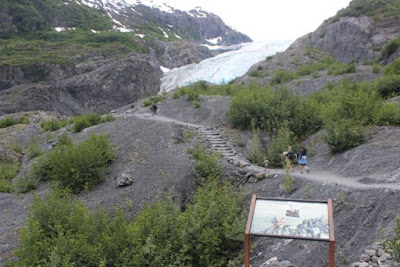We met in 2010 when he left a comment on this post about Exit Glacier and we connected before he and his family returned to Spain. Here's a post with pictures of Tómas and his family and his great kids book Salfón: El limpiodor de tejados.
His wife will be teaching science (I think) in a Spanish language high school program in Lexington. And I'm sure Tómas will be drawing. In fact he sent me his first US drawing.
I did mention that while he is visiting in Kentucky, he would surely be drawing McConnell. Let's see how his take on the senior Senator from Kentucky evolves over the year.
Meanwhile I picked up a second book on Peron at the library today - Perón and the enigmas of Argentina by Robert D. Crassweller. This one starts out trying to capture who Perón was by looking at the many long term cultural influences. One of them is "the heritage of Castille" which he traces to 1492 when the Moors left and the Reconquest.
"That long and arduous crusade had deeply marked the Castilian character and personality. Society was pastoral and had lived by war for centuries, disdaining lesser and demeaning pursuits such as commerce. A powerful and authoritarian state emerged, energized by effective government. The parliament of Castile, the Cortes, lacked the power of the purse and soon languished. Royal power, resolutely exercised, curtailed any political role for the aristocracy, which contented itself with social privilege, and there was no significant challenge from below.I'm just quoting, not saying it's accurate. It's certainly simplistic, as a short synopsis like this must be. After all, the subjects of the religious persecution - non-Catholics, particularly Jews - didn't have their rights and dignity protected and probably would disagree.
Freedom in the Anglo-Saxon sense of the world was not a product of these tendencies, but that implies neither tyranny nor misrule All the monarchs of the age were popular and intuitively sensitive to public moods and aspirations. Thus royal authority was willingly accepted and viewed as consistent with freedom and liberty. Absolutism, tied to religious values, was not seen as tyranny, since individual rights and dignity were protected." (pp. 24-25)
What I found particularly interesting was a description of the Spanish state and church ruled a much different culture than that in northern Europe.
"The State had never known feudalism in the the northern European sense of a system with centers of politics power apart from, and often in opposition to, the royal authority. There had been no Magna Carta inSpain, no warlike barons jealously and successfully protecting their local powers, no system of courts enforcing laws that did not originate with the king's justice. The Church was the Church of the Counter-Reformation, necessarily broad and pluralistic in many respects, a palace of many chambers, but nowhere in it had there been any experience in sharing of the power that was tightly consolidated in the successors of St. Peter.Again, I can't judge how accurate this is, but it seems appropriate to do a little Spanish history as I welcome Tómas and his wife to the US. But let me do a little more. So far he's talking about what the Spanish heritage Perón would eventually inherit didn't do well, but he goes on to talk about what it did well. He does a paragraph about the philosophy and political thought coming from Aquinas, Aristotle, and Renaissance Scholasticism, not from the social contract theory of Rousseau, Locke, and Hobbes.
Thus neither Crown nor Church could contribute to the traditions, the techniques, and the psychological attitudes that are essential for adjusting successfully the claims of competing power centers in a society containing many such. The arts of compromise and conciliation, and the habits of mind necessary for their appreciation, were dormant and underdeveloped."(25-26)
"Rather, it was a powerful stimulus to an organic theory of life and of the State, a theory of natural harmony in which every human and every institution had a purpose, a station, ordained and secure. And it was also a powerful support for the prevailing Mediterranean and Iberian corporatism, defined in the broad sense of a 'sociopolitical organization that is . . hierarchical, elitist, authoritarian, bureaucratic, Catholic, patrimonialist . . ."While it may seem I've taken quite a bit from Crassweller, he would probably say I left out the most important parts. And this is only one of the cultural heritages he's telling us we need to understand if we are going to get a good sense of Perón. Another will be the creole heritage. I like the idea of going back like this to find influences on Perón, but I also realize it's a risky act. Is he going back and finding things in Spanish culture that manifest themselves in Perón, leaving out much that is not 'Perón"? I can't judge. Maybe Tómas will be the best evaluator of this cut and paste Spanish heritage.
"Castilian society exalted courage and honor and defined them in an exclusive and stringent code as ideals appropriate for the man of rank, the gentleman, the hidalgo. For such a man and such an ideal ". . . work did not redeem and had no value in itself. Manual work was servile. There was little or no interest in science and its fluid experimentation, or in technology and technique in general, or in any kind of economic activity. The superior man neither worked nor traded: he made war, he commanded, he legislated. He also thought, contemplated, loved, wooed, and enjoyed himself. Leisure was noble." (26)
[Kathy, for some reason my brain says you're in Louisville, which isn't that far, but not that close either. Am I right?]









